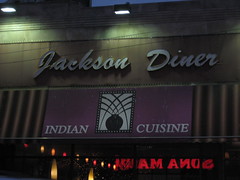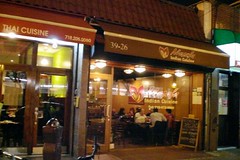|
|
BusinessesFrom The Peopling of New York City: Indian Communities
While the dominant assumption is that South Asian immigrants- educated Indians in particular- tend to engage high-wage professional or entrepreneurial positions in New York, in reality a sizable and increasing number have only partial formal education and are employed in low-wage industries. Even if workers are educated, they have few options but to take low-wage jobs. According to Johanna Lessinger, Indian immigrants are often only able to find work as waiters, deli countermen, shop clerks, newsstand employees, security gaurds, or taxi drivers.
Jackson HeightsMany different types of Indian businesses can be found in "Little India" of Jackson Heights. As Jackson Heights is called Little India, most of the businesses found there are in fact Indian-owned. There are many large-scale as well businesses throughout Jackson Heights, as it is quite a popular place for native Indians to spend time at. Immigrants from India remain emotionally attached to the food they grew up with in their native land. The ethnic Indian food restaurants and sweet shops in Jackson Heights, such as the Jackson Diner and Shaheen's Sweets, are considered Queens eating at its best, while charming Bollywood music shops and movie theaters continue to bring business in for their owners. On the same block, you can find the Palace Theater showing Bollywood movies, and the Raaga Super Store playing electro-Indian pop music. The Indian people that often go to Jackson Heights believe that it reminds them of home, because they can find all the same goods, music, and culture that they could back home in India. Jackson Heights has its fair share of small, Indian grocery shops, sari shops, and beauty salons.
FlushingFlushing is known more for the largest, wealthiest Chinatown than Indian businesses. However, many Indians reside in Flushing, Queens, although with smaller-scale businesses than places such as Jackson Heights. Flushing has many small Indian restaurants and beauty parlors. However, there has been a problem of overdevelopment of downtown Flushing since 1990. Businessmen have been partnering up with city developers in order to build luxury condos and monopolize businesses, taking over many small residential businesses, including Indian-owned ones. Richmond HillRichmond Hill is known for its large Sikh community, one of the largest in New York City. It is common to find a mandir (Hindu temple) next door to a small, family-run Indian mini-mart. This shows us the fusion of New York American life with Indian religious culture. As the family unit and community is very important to all Asian immigrants, particularly Indian immigrants, they tend to run smaller businesses as opposed to larger ones. Businesses exist primarily to support the community, and there are many unionized workers working in very small-scale restaurants, catering to the local populus. The community comes together, especially during the Phagwah Festival.
AstoriaAstoria is believed to be a true melting pot of New York City. Though Greeks make up the largest part of the Astoria population, immigrants predominantly from Bangladesh and India also constitute a sizable population in Astoria specially around 32nd Street and 34th Avenue. Many Indian immigrants decided to settle in Astoria for the relatively low cost of living that can be found there, as well as for the fact that it is quite family-oriented. Farthest south is 36th Avenue or Dutch Kills, a low-density commercial area that features traditional Bengali and Indian restaurants and shops. Indians and other immigrants enjoy living in Astoria for the close community, despite an enormous amount of diversity.
WoodsideWoodside of Queens is a primarily Irish neighborhood, but Asian Americans have been steadily moving in since the 1990's. South Asians, including Indians Americans, Bengladeshi Americans, and Pakistani Americans as well as Mexicans and Dominicans live there as well. Woodside is a mostly middle-class, immigrant neighborhood, so it is simple to find restaurants and shops of all ethnicities. Woodside contains Divya Dham, a Hindu temple in the manufacturing area of Woodside. Hindus from all over New York City to worship there, where all divinities are worshiped.
CoronaCorona was transformed from a rural community in Queens to a densely settled neighborhood when the Long Island Railroad was built in 1854. It is primarily Italian and Hispanic, with a small amount of Asian Americans, including Indians, and Pakistanis. Corona is a smaller, rural area compared to other parts of Queens and New York City, with a very small number of low-scale Indian restaurants and beauty shops. Murray HillMurray Hill is the tiny stretch of Lexington Avenue between 27th and 30th Streets and has been known as "Little India" for some 20 years. These days, locals call it "Curry Hill" because of the large number of Indian-owned ethnic food restaurants. There are about twelve Indian restaurants in the three blocks that make up Murray Hill, all relatively small and inexpensive. There are many expensive apartment buildings along Murray Hill. Recently small, private family homes have been demolished for two-family homes to be built in their places. |



